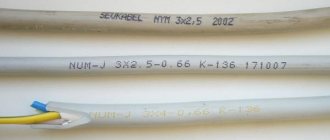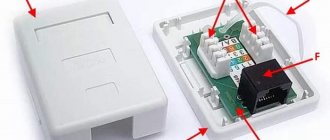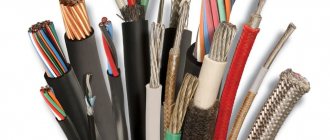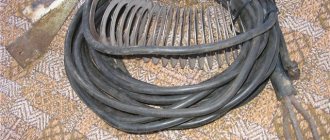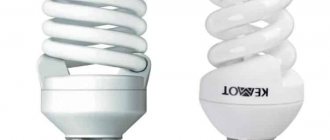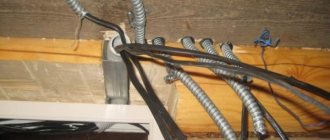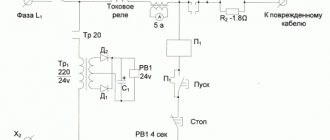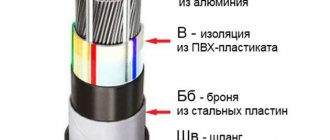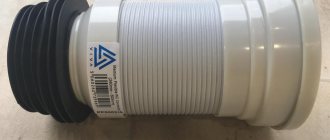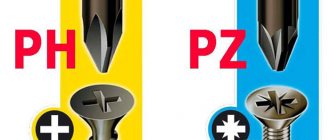To connect new household equipment or make high-quality extension cords (surge protectors), ShVVP wire is most often used. Cords are made from it for most types and models of household appliances.
At more powerful production facilities, for powering consumers in high-voltage electrical networks, preference is given to other analogues. Only in rare cases can it be used to arrange a temporary power line.
Explanation of the name of the SHVVP wire
The Russian-language marking of the SHVVP wire is deciphered quite simply. With its help you can get a brief description of the electrical installation product:
- The first thing you need to pay attention to is the absence of the letter “A” at the beginning of the abbreviation. By its presence or absence in the designation of any cable, one can judge the material of the cores - aluminum or copper, respectively. And SHVVP is a copper conductor.
- The letter “B” indicates that the core insulation is made from high-quality polyvinyl chloride.
- The second letter “B” indicates a similar material for the manufacture of the outer shell, under which all the cores are hidden at once.
- The letter “P” means that the ball screw cord is flat (all cores are arranged in parallel, regardless of the number).
Important! Despite the flat structure of the wire, the cores can be twisted into various rounded shapes.
This cable is often modified and improved. The appearance of one or another useful quality must be indicated in the labeling. For example, the symbols “ng” can be added to the SHVVP through a hyphen. They say that the insulation material does not support combustion. The prefix from the Latin letters LS means that during the combustion process the insulation emits a minimal amount of smoke and harmful substances.
Decoding the abbreviation SHVVP
The name of the product usually tells us a lot of information about the properties of the product and its areas of application. Therefore, let’s decipher the abbreviation SHVVP:
- Ш – means “cord”;
- B - indicates the type of core shell. In this case, a polyvinyl chloride shell;
- B in the second position of the abbreviation characterizes external insulation (polyvinyl chloride);
- the letter P is the profile configuration, that is, flat.
Judging by the decoding of the ShVVP brand, we can conclude that in this case we are dealing specifically with the category of connecting cords. Let's take this into account, although people call them wires and even cables, but such names, strictly speaking, are incorrect.
In this article we will use the popular name “flexible wire”, remembering that in essence it is a cord.
Design
Considering the design features of the SHVVP cable, three main points can be distinguished:
- the composition includes several wires insulated from each other, consisting of many thin wires;
- all cores have a round cross-section;
- There is general insulation made of PVC plastic.
It was written above that the veins, regardless of the number, are arranged in parallel. By the color of the insulation of each core you can judge what it is intended for:
- the blue sheath indicates the neutral wire;
- yellow-green – grounding;
- brown or red – phase.
Two-core cables are often produced in which there is no possibility of grounding.
This is interesting! Often, manufacturers of electrical (in particular, cable) products produce ball-type conductors with copper-aluminum conductors. In this case, the quality of electrical signal transmission deteriorates, but the cost of the final product and, accordingly, electrical installation work decreases.
Decoding and types of SHVVP wire
To answer the question of what is the purpose of the SHVVP wire, deciphering its name and design features will greatly help us. Therefore, our article should begin with the definition of these parameters.
Explanation of the name of the SHVVP wire
Let's start by deciphering the wire markings. After all, it will not only allow you to find out the purpose, but can also say a lot about the structure and design of the wire.
ShVVP wire structure
So:
- The first letter - Ш , tells us that this is a cord. Unlike ordinary wire, the cord has increased flexibility and must be insulated. The wire may not have insulation.
- The second letter is B. She talks about the structure of the cord insulation. “B” stands for vinyl insulation, which is also often called PVC plastic.
- The third letter is again "B" . This means that the cord of this brand has double insulation, or, as it sounds more correct, a vinyl sheath. If a cord consists of several wires, then the first layer of insulation usually covers the conductor itself, and the second layer covers all the conductors of the cord. This is also true for the SHVVP wire brand.
- The fourth letter is P. It means the cord is flat. That is, all wire strands are located in parallel, regardless of their number. In addition to the flat arrangement of the wires, they can be twisted, which gives the wire a round shape.
- In addition to the main four letters, the instructions allow the application of one more capital letter to the wire marking . These can be the letters “n”, “l”, “t” or “ng”, which in modern markings can take the form “LS”.
Tinned wire ShVVP
- The abbreviation “l” means the use of tinned copper in the conductor. This reduces the likelihood of copper corrosion and simplifies soldering.
Plug-reinforced wire
- The abbreviation “l” means that it is inadmissible to reinforce this wire with non-removable fittings. In simpler terms, permanent plugs or sockets cannot be soldered to such wires. They must be attached to the wire only using terminals.
- The abbreviation “t” tells us about the increased temperature resistance of the wire. Thanks to this, it can be used in hot and sometimes humid areas.
Note! The abbreviation “t” does not allow the wire to be used in direct sunlight. In general, all vinyl-insulated wires do not tolerate direct sunlight very well.
Wire fire resistance test
- ShVVP brand wire may additionally contain the abbreviation “ng” or “LS” . This marking means that the wire is non-flammable and has a low percentage of smoke and gas emissions.
Wire version SHVVP
Important factors when choosing are such parameters as cross-section, number of wires and, in some cases, color of the wire. Therefore, let's look at the possible options separately.
ShVVP wire sizes
- First of all, let's focus on the section. According to GOST 7399 - 97 ShVVP wire can have a cross-section of 0.5 mm2 or 0.75 mm2. Large cross-sections of current-carrying parts are not provided for this type of wire. Based on this, the rated currents for cords of this type are not very large.
Possible options for standard sizes of SHVVP cord
Note! Now on the market you can find SHVVP wires with core cross-sections of 1, 1.5, 2.5, 4 and even 6 mm2. But these wire brands are not standardized by GOST 7399 - 97 and therefore the characteristics described below are not always applicable to them.
- The next important parameter is the number of current-carrying wires. According to the same regulatory document for this brand of wire, two- and three-wire versions are possible. In this case, the cross-section of these cores can be 0.5 or 0.75 mm2.
Placement of individual wires in each core of the ball screw
- To increase the flexibility of the cord, each strand of the wire consists of several wires. So, according to GOST 22483 - 77, for our wire, each core must have at least 7 wires. In this case, the diameter of each wire should be no more than 0.33 mm for conductors with a cross-section of 0.5 mm2, and no more than 0.38 mm for conductors with a cross-section of 0.75 mm2.
- The next important issue is the thickness of the insulation. Regardless of the cross-section and number of cores in the cord, the thickness of the core insulation must be at least 0.5 mm. The thickness of the shell should be even higher and be at least 0.6 mm.
- Another possible difference is the color marking of the cores and sheath of the cord. The shell is usually made in a standard white color and only in rare cases can it be made in black. But the wire cores can have a rich color palette, which, by the way, is determined by GOST 7399 - 97. The price of the wire usually does not depend on the color of the wire cores.
Rules for the color designation of wires according to the PUE
Note! If you choose a wire for household purposes, it is better to choose a wire with a color that complies with the PUE standards. For a single-phase three-wire network, one of the wires must be blue, one wire must be yellow-green, and one wire can be any other color. For a single-phase two-wire network, the neutral wire should be chosen with a blue color, and the phase conductor can be of any other color.
Types of SHVVP wire
There are several main criteria used to classify CVVP:
- cross-sectional area of the current-carrying conductor;
- their number;
- product color.
We list the main variations of this cord depending on technical and operational parameters:
- The corresponding clause of GOST strictly defines the permissible values of the cross-sectional area of the SHVVP conductor - 0.5 or 0.75 square meters. mm. If you find a cable of a different cross-section in a store, then you should know that it is not provided for by domestic standards, but can still be used (certificates are not issued for such products). Depending on the number of current-carrying cores, two- and three-core cables are produced. Let us repeat that 0.75 sq. mm is the cross-sectional area of one of them.
- The core consists of several wires twisted together, which provides increased flexibility of the product. In accordance with GOST, their number must be at least seven pieces. The diameter of the wire in the SHVVP cord with a core cross-section is 0.5 square meters. mm is 0.33 mm, 0.75 sq. mm – 0.38 mm.
- Regardless of the specific values, the thickness of the insulation on each core must be at least 0.5 mm, the outer sheath - from 0.6 mm and above.
- It was written above about the color difference of the ball-and-ball cord. In most cases, the outer sheath of the cable is white, but some manufacturers produce products in black. The coloring of the outer protective layer does not affect the pricing policy and does not indicate better or worse technical and operational parameters.
Characteristics
We list the main features of this product:
- consists of two or three conductors laid in parallel, each hidden in a durable PVC sheath;
- all cores are multi-wire (no monolithic cords);
- flexibility class – 5;
- the shell is made of polyvinyl chloride;
- voltage – 220/380 V;
- cable cross-sectional area – 0.35-2.5 sq. mm;
- operating temperature range – from -40 to +40 degrees. Celsius;
- rated current value - calculated in accordance with the cross-section and number of cores.
Mechanical properties
The greatest contribution to the popularity of the SHVVP cord was made by its mechanical characteristics, so the wire is used where increased demands are placed on them:
- ShVVP has unsurpassed flexibility, as indicated by the minimum bending radius - 5 outer diameters of the wire. Since the cable is flat, in the calculations it is enough to use the minimum thickness of the product, so none of the conductors can compare with it in terms of flexibility.
- During the manufacturing process of ball screws, they try to ensure high resistance of the product to repeated bending and extension. Usually up to 30,000 such cycles are laid.
- Despite this, such actions will sooner or later affect the technical parameters of the product. Manufacturers warn consumers that if exposed to constant bending and straightening, the service life of the wire is reduced to two years. In normal mode it is 10 years.
- It is noteworthy that when undergoing technical tests, the wires are checked not only for bending, but also for tension. In accordance with GOST, the ShVVP cable can withstand up to 9.8 N of pulling load, without causing any visible damage. During this test, the cable sheath is removed.
- Before being sent to store shelves, the cord is tested in a special chamber at a temperature of +80 degrees. Celsius. He stays there for 90 hours. Upon completion of this process, wait another two to three hours until the conductor cools completely, after which they make sure that there are no visible defects.
- The test of ball-and-pressure balls at low temperatures looks much tougher. The cooled cord is pulled under a roller with a cross-section equal to four outer diameters of the cable. The wire is then tested for shock resistance. A valid product is considered to be one that has passed all of the above checks and is not damaged.
- In the standard version, the operating temperature range is from -25 to +40 degrees. Celsius. Above, we indicated increased limits that are relevant for ball-type conductors in special climatic versions. Regardless of the operating conditions when using the cable, the temperature of one core should not exceed +70 degrees. Celsius.
Electrical properties
Ball screws would not be so popular without good electrical characteristics, which describe the efficiency of the main purpose of the product - passing current. Let's list the main points:
- The main electrical parameter of any wire is resistance. In accordance with GOST for ball screws with a cross section of 0.5 sq. mm at core temperatures up to 70 degrees. Celsius its value is at least 0.012 Mohm. For cable with a cross section of 0.75 sq. mm this parameter will drop to 0.01 Mohm. These figures may seem high, but it must be taken into account that the measurements were tested on a 1000 m wire.
- Another important characteristic is the insulation resistance. To obtain a specific value, you need to measure the insulation resistance between the core and the ground, as well as between two adjacent cores.
- To test the last parameter, take a piece of cord of a ball-and-pressure device with a length of at least 5 m. It is placed in water, then a voltage of 2 kV is applied and the leakage current values are measured.
- To check the insulation resistance between two adjacent conductors, take a piece of ball-type conductor with a length of at least 2 m. The sheath between the conductors is cut. The further process is similar - the cable is lowered into the water, voltage is applied, and the leakage current values are measured.
Specifications
When choosing wires (cords) for ball screws, you need to focus on their technical characteristics. The most important technical characteristic is the cross-section of the conductors, which characterizes the optimal current loads that the wire can withstand. This data allows you to calculate the safe parameters of future electrical wiring or extension cords intended to connect electrical appliances with the appropriate power.
For convenience, let's create a table:
Table 1. Some technical characteristics of common ball screw cords.
| Core cross-section, mm2 | Number of cores | Parameters of insulating shells | Rated current load, A / taking into account the number of cores | |
| Thickness of the internal insulating layer, mm | Outer shell thickness, mm | |||
| 0,5 | 2 / 3 | 0,5 | 0,6 | 3×2 / 3×3 |
| 0,75 | 2 / 3 | 0,5 | 0,6 | 6×2 / 6×3 |
| 1,0 | 2 / 3 | 0,6 | 0,8 | 10×2 / 10×3 |
| 1,5 | 2 / 3 | 0,7 | 0,8 | 14×2 / 14×3 |
| 2,5 | 2 / 3 | 0,8 | 1,0 | 20×2 / 20×3 |
| 4,0 | 2 / 3 | 0,9 | 1,1 | 25×2 / 25×3 |
The main characteristics of the wire can be learned from its markings, which are applied to the outer insulating sheath (Fig. 3).
Rice. 3. Marking on wires
Insulation markings indicate:
- brands of connecting wires;
- the number of wires in the wire and their cross-section;
- information about the manufacturer;
- length of wire in the bay and other data.
For example, the inscription SHVVP 3 1.5 means: a cord with polyvinyl chloride sheaths, three-core, with a core cross-section of 1.5 mm2.
In more detail, the ShVVP brand cord characterizes the following indicators:
- the wire is designed for voltage 220/380 V, when transmitting alternating current with a frequency of 50 Hz;
- the cord can withstand a voltage threshold of up to 2 kV for a period of time of no more than 15 minutes;
- electrical insulation resistance – not less than 0.01 mOhm/m;
- the minimum cross-section of the cores is 0.35 mm2, and the maximum is 6 mm2;
- the time of use of the cord is limited by its service life, which can range from 6 to 15 years, depending on conditions;
- the resistivity of copper conductors is 0.27 Ohm×m/mm2;
- operation is permissible at air temperatures from –40 to +40 ºC;
- permissible heating of the core should not exceed 70 ºC;
- installation is allowed at temperatures from – 10 ºC to +30 ºC;
Based on the parameters of the mechanical characteristics, the conclusion suggests itself: the power cable of the SHVVP can be used both indoors and in open areas. However, it should be remembered that when exposed to sunlight, vinyl insulation ages. As a result of alternating frequent temperature changes and under the influence of light, the service life of the cord is reduced to the lower limit (6 years).
The fact is that in open space some additives gradually evaporate, as a result of which the structure of the plasticizer changes. Cracks appear on the outer shell, which spread to the inner coating, as a result of which the insulation resistance drops. When such signs appear, further operation becomes unsafe.
For safety reasons, choose a cable for wiring with a certain power reserve for current loads, focusing on the technical characteristics of the products. Do not allow the service life of the wires to be significantly exceeded, especially outdoors.
Application of cords
ShVVP can be successfully used both in home and outdoor conditions. The maximum cross-section of non-standard cables does not exceed 2.5 square meters. mm, so they are not suitable for switching high power equipment, including heaters, electric kettles, workbenches, etc.
ShVVP is actively used in the following areas of life:
- electrical installation of lighting systems and small tabletop household appliances;
- production of extension cords and connecting carriers;
- connecting low-power household appliances (TVs, washing machines, computers, etc.) to an industrial electrical network with voltage up to 380 V;
- Can be used as an acoustic cable.
Important! You cannot use an extension cord created on the basis of a ball-type power supply for switching several low-power electrical appliances at once. Their values are added together and the final value may be excessively large, resulting in significant overheating and potential fire.
Manufacturers
Among the domestic manufacturers of ball-type cords that have proven themselves among consumers and electricians, it is worth highlighting Sevkabel. The Verkhneoksky Cable Plant (VKZ) also produces good quality products. If you encounter a cable from other manufacturers and have doubts about the quality of the product, then use a caliper to determine the approximate thickness of the wire and calculate the cross-sectional area of the core.
Ball-type cords are a high-quality and inexpensive product suitable for temporarily connecting low-current household appliances to an industrial power supply network with a voltage of 220/380 V. Still, for stationary high-power installations, including machine tools and gaming computers, you need to use a cable with a large cross-section. Unlike SHVVP, the PVA cable can handle increased current load.
Also, when working with ball-type extension cords, constant monitoring and supervision must be ensured to prevent overheating and potential fire. If the temperature rises, the conductor needs to be replaced.

